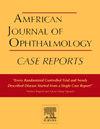Virtual reality perimetry facilitates visual field evaluation in a previously non-assessable eye with severe glaucoma
Q3 Medicine
引用次数: 0
Abstract
Purpose
Virtual reality perimetry (VRP) is rapidly growing in popularity. Advantages of these devices have been noted in the literature: they require less capital investment than table-mounted perimeters, have a smaller footprint, and improve patient comfort. Unlike traditional perimeters, virtual reality perimeters can assess both eyes simultaneously, which it does by default on most of its testing algorithms. This novel function leads to an advantage of VRP over traditional perimetry that has not yet been reported: the ability to assess the visual field of an eye with poor fixation. We report a patient with advanced glaucoma who could not perform reliable standard perimetry due to a central scotoma in one eye but could perform VRP testing of each eye simultaneously.
Observations
A 23-year-old male with advanced congenital glaucoma in the left eye presented for follow-up perimetry testing. In prior visits, his right eye consistently demonstrated a normal visual field, but left eye showed a progressively worsening global defect with poor reliability indices. At the present visit the patient performed VRP, which tested both eyes simultaneously. Good fixation with the right eye facilitated a reliable visual field of the left eye.
Conclusions and importance
The virtual reality perimeters tests both eyes simultaneously, which traditional perimeters cannot do. In this case, fellow eye fixation facilitated the acquisition of a clinically meaningful visual field from a poorly fixing eye due to advanced glaucoma.
虚拟现实视距法有助于对先前无法评估的严重青光眼进行视野评估
目的虚拟现实周边测量技术(VRP)正在迅速普及。这些设备的优点已在文献中指出:他们需要更少的资本投资比桌面安装周长,有更小的占地面积,并提高患者的舒适度。与传统的周界不同,虚拟现实周界可以同时评估两只眼睛,大多数测试算法默认都是这样做的。这种新功能导致VRP优于传统的视野检查,但尚未有报道:能够评估固定不良的眼睛的视野。我们报告了一例晚期青光眼患者,由于单眼中心暗斑而无法进行可靠的标准视野检查,但可以同时对每只眼睛进行VRP检查。一位23岁男性左眼先天性青光眼晚期患者接受了随访的眼部检查。在之前的就诊中,他的右眼始终表现出正常的视野,但左眼表现出逐渐恶化的整体缺陷,可靠性指数较差。在这次就诊中,患者进行了VRP,同时对两只眼睛进行了测试。右眼良好的固定有助于左眼的可靠视野。结论及重要性虚拟现实周长可以同时检测双眼,这是传统周长无法做到的。在本例中,由于晚期青光眼导致的眼睛固定不良,同伴眼固定有助于获得临床有意义的视野。
本文章由计算机程序翻译,如有差异,请以英文原文为准。
求助全文
约1分钟内获得全文
求助全文
来源期刊

American Journal of Ophthalmology Case Reports
Medicine-Ophthalmology
CiteScore
2.40
自引率
0.00%
发文量
513
审稿时长
16 weeks
期刊介绍:
The American Journal of Ophthalmology Case Reports is a peer-reviewed, scientific publication that welcomes the submission of original, previously unpublished case report manuscripts directed to ophthalmologists and visual science specialists. The cases shall be challenging and stimulating but shall also be presented in an educational format to engage the readers as if they are working alongside with the caring clinician scientists to manage the patients. Submissions shall be clear, concise, and well-documented reports. Brief reports and case series submissions on specific themes are also very welcome.
 求助内容:
求助内容: 应助结果提醒方式:
应助结果提醒方式:


